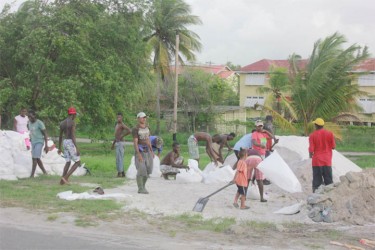“Gravely concerned” at the recent massive overtopping of sea defences along the Rupert Craig Highway, the European Union yesterday announced that it was extending a mission currently underway here which would make “concrete recommendations” to mitigate recurrences.
On April 28, high tides crashed over the East Coast highway sea defences in what residents said was the worst occurrence of its kind in recent memory. Salt water flooded yards for several streets and there was traffic chaos. This was the third episode of its kind in recent months and left residents fearful of what might be ahead. Sections of West Demerara were also severely affected.
Yesterday, the European Union, a major financier of the sea defence sector here weighed in. In a statement, the EU said that it had swiftly requested an extension of a technical mission by a coastal engineering design expert from the Denmark-based Consultancy with Engineering, Environmental Science and Economics (COWI). The expert is presently in Guyana engaged in related works for the EU.

“At the same time, the EU has been providing to the Government of technical expertise in the sector of coastal and marine structures and construction. The coastal engineering expert has recently assessed the quality and extent of the support provided by the EU in the recent reconstruction of sea defences at various sites along the coast (9th EDF with EUR 17 Million), in order to advise the Government of Guyana in further development of its Sea Defence Strategy, which the EU is preparing to support by contributing up to EUR 15 Million over the next three years”, the EU said.
It added: “As a matter of urgency, the EU has therefore agreed to extend and expand the mission of the COWI expert (who is presently in the country), to assess the overtopping of the sea defences along the Rupert Craig Highway and to make concrete recommendations to the Ministry of Public Works to mitigate future occurrences. The expert is expected to provide his final report and recommendations to the EU and the Ministry of Public Works by the end of June.”
Head of the EU Delegation in Guyana Robert Kopecký is hopeful that the consultant along with the technical team from the Ministry of Public Works will be able to devise an effective strategy to address the matter, the statement added. The ambassador applauded Public Works Minister Robeson Benn and his team for their handling of the overtopping.
The overtopping has left local engineers here divided over what, if anything, can be done to alleviate the situation along this stretch of the coast. It has also seen the Ministry of Public Works being criticised for the loss of institutional memory and the inability to undertake the necessary surveys and investigations of sea defences.
Benn yesterday told Stabroek News that temporary measures such as the sandbags being laid along the Rupert Craig Highway are currently the best solution in dealing with overtopping. Benn said that to place rip-rap lining across three kilometres of highway could cost $1 billion. He told Stabroek News that “this is the same erosion front that has moved along the coast from Montrose”. Benn said that to spend money on more permanent solutions would be a waste of money as the same weather phenomenon has crept along the coast from Montrose to Liliendaal and now to the Kitty seawall area.
“The remedy that is being proposed, the boulders, the rip-rap requires enormous expenditure…we lost the mangrove fringe and the area across from the Russian Embassy is a low area, if we spend a billion every time [overtopping] moves that is just not money well spent,” Benn stated. He said that the trajectory of the overtopping seems to be moving along the coast in four to six months spans so while more long-term solutions are crafted the significantly cheaper sandbags are preventing a bigger disaster.
The minister said that “the effects although they were dramatic were not as severe as at Montrose (several years ago) and we have taken the necessary steps to clear drains that already helped the situation”. Benn noted that the Public Works Ministry has been collecting data and has applied simple yet significant changes that reduced the effects of overtopping.
He stated that the moving of the Sunday night weekly seawall lime along the Rupert Craig Highway is another measure that is aimed at preserving the seawall’s resistance to the elements. Benn said that the initiative to move the vendors to a safer area will reduce garbage and the clogging of drains along the seawall.
Benn added that the Public Works Ministry is looking at the shore erosion along the seawall. He said that for now the seawall was structurally sound. Benn stated that on a more permanent basis the ministry was looking to build groynes. He noted that the current groyne located on the Carifesta Avenue portion of the seawall was assisting with the breaking of the waves. Benn told this publication that slowing down material and shell build up can vastly improve regrowth of vegetation. He stated “that material can promote regrowth of vegetation either naturally occurring or like we’ve been doing with the mangroves.”
COWI’s website said it is a consulting group that creates value for customers, people and society through its unique 360° approach. It said that based on its world-class competencies within engineering, economics and environmental science, it will tackle challenges “from many vantage points to create coherent solutions for our customer.”





